An Uncommon Jo;Wilbur Bench Plane
In the middle of November, 2012 I made my usual visit to the
local Sunday morning flea market. This weekly affair generally has a
couple of hundred dealers show up, from around eastern Massachusetts, Rhode
Island, and as far away as Connecticut. The week to week finds are spotty.
Some days only a couple of saleable or useable tools will come home with me,
although other days might produce fifteen or twenty tools. Rare it is that
a real "sleeper" crops up, although it is always possible. On this
occasion the early findings were pretty slim. The market opens at 5
am--more than two hours before sunrise, so flashlights are in order for the
first hour or two. The field fills up with an early spate of regular
dealers, and then stragglers show up throughout the next three hours or so.
The learning curve is pretty steep, but eventually the regular buyers know the
early arriving dealers, and what sorts of things they might bring. I'm
lucky enough to know several guys who know a little bit about tools, and who
will usually put them aside for me, if they have them. So I generally
cruise the early field, looking for these guys.
An hour after the opening rush I'd found only two decent tools,
including a decent example of a common Stanley bevel and a type 8 Stanley jack
plane. When I looked closely at the plane when the sun came up, it proved
to have a cracked body casting, but fortunately all else was in good order, so
the parts were worth what I paid for it.
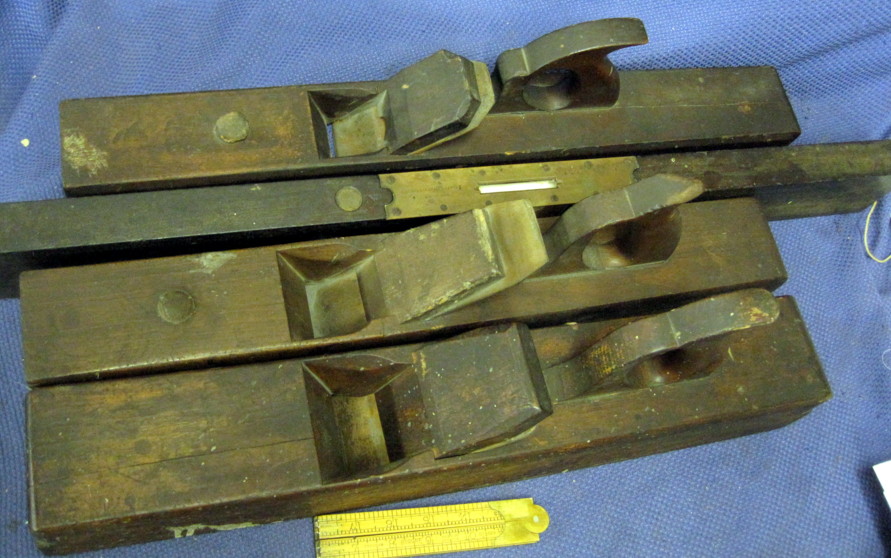 Then,
as the sky was lightening I found two guys unloading a large van, and spreading
their stuff out on benches. A group of 3 wooden jointer planes and a
wooden bench level caught my eye. The obviously interesting plane was a
26" slim jointer with an offset handle and flat chamfers that just screamed
"18th Century". The nose was pretty dirt encrusted, but the flashlight
showed a 3-line incuse maker's mark--and so with no further ado that plane went
to the ground between my feet--to be more closely examined later. The next
interesting item was the wooden level. This was easy to identify--a
Mulliken & Stackpole level with the older stamp (probably 1856-58), with brass
tips and side views. The condition was really great for a level of this
age- It was Cuban mahogany, with good edges, vials and no chips or cracks.
So this joined the jointer plane between my legs (hey, you never let go of a
flea market tool before getting a price). The other two jointer planes
were decent--one by Thos. Appleton and another unmarked one. They weren't
bad, but just were not easy sells.
Then,
as the sky was lightening I found two guys unloading a large van, and spreading
their stuff out on benches. A group of 3 wooden jointer planes and a
wooden bench level caught my eye. The obviously interesting plane was a
26" slim jointer with an offset handle and flat chamfers that just screamed
"18th Century". The nose was pretty dirt encrusted, but the flashlight
showed a 3-line incuse maker's mark--and so with no further ado that plane went
to the ground between my feet--to be more closely examined later. The next
interesting item was the wooden level. This was easy to identify--a
Mulliken & Stackpole level with the older stamp (probably 1856-58), with brass
tips and side views. The condition was really great for a level of this
age- It was Cuban mahogany, with good edges, vials and no chips or cracks.
So this joined the jointer plane between my legs (hey, you never let go of a
flea market tool before getting a price). The other two jointer planes
were decent--one by Thos. Appleton and another unmarked one. They weren't
bad, but just were not easy sells.
Calling to one of the nearby guys unloading the truck, the
first question--always--is, "Hey Buddy, you have any more tools than these?" [It
is strange that almost all flea market dealers are named either, "Buddy," or
"Mac."] Apparently I guessed right, and he answered, "No. That's
it."
Next question, holding up the level and slim jointer, "How much
for these two?" Answer - "I'm selling all four of those tools together.
If you don't want all of them, I'll take all of 'em back to Newport."
This was interesting information. The tools apparently
came from the Newport, Rhode Island area, maybe 30 miles distant.
Next question, "How much do you want for all four?" The
answer was a number that was about double what I'd expect from the usual flea
market dealer, but still within a range that I could live with. The next
no-no of flea markets is never accept the dealer's first price.
So I answered with a low-ball offer, and he countered by
splitting the difference between us, plus a little more on his side. That
was ok with me, and I walked away to stash the planes and level in my truck
before returning to the grounds. Not too much transpired in the next hour,
except finding a decent shiny Stanley 923 brace and a Millers Falls No. 5 drill
for parts. Maybe the best buy of that hour was a group of eight unused
brass swordfish harpoon darts for two bucks, and then the dealer threw in a
large spool of tarred marline for free. That alone paid for the morning's
gasoline. At eight am it was time to leave to get cleaned up for my
morning's volunteer work at the Whaling Museum.
In the afternoon, after coming home from the museum, I pulled
out the planes and level and took a good look at them. The two bulky
jointer planes and the level were as I figured--no surprises there. But
the slim jointer, in the light of day, had an easily readable mark on the toe,
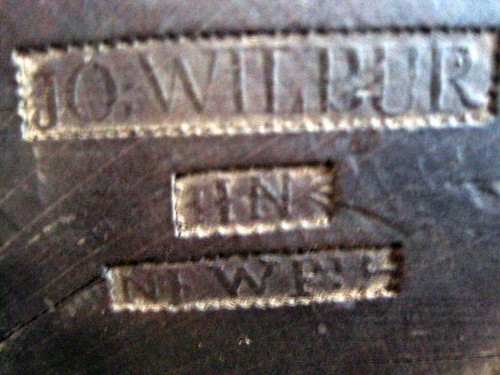
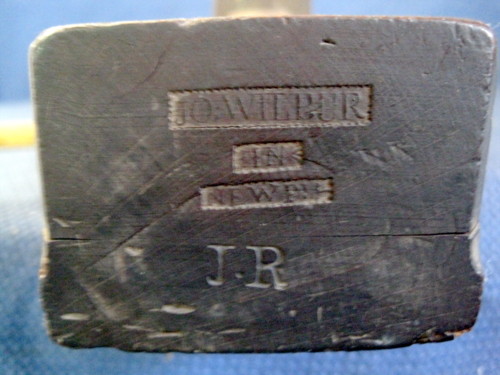
Picking up "The Guide to American Wooden Planes" 4th edition it
was easy to learn the JO (Joshua) Wilbur (1758-1836) was a plane maker in
Newport, Rhode Island for a period from about 1785about 1802, when he decamped,
and moved to upstate New York, dying there in 1836. JO; Wilber planes are
scarce, it being estimated that fewer than about 50 exist today. And
planes with this, the A mark, are exceptionally rare, rating five stars stars
for rarity (fewer than 10 examples known). Actually, as will be seen
later, the number of Wilbur planes with this mark number only 4, counting this
one.
What also makes this plane so unique, is that marked American
wooden planes, dating to the 18th century, are almost always molding, filletster,
or plow planes. Ordinary bench planes (smoothers, fore planes and jointer
planes) either were not often marked by their makers, or have long been used up,
converted to other purposes, or discarded. Apparently this plane is the
first JO; Wilber plane with a Newport mark to have surfaced.
A friend of mine, Richard (Rick) Slaney, of Pawtucket, RI, has
extensively researched Rhode Island plane makers. His research on JO
Wilber was first published in the EAIA Chronicle of March, 2003 (Vol. 56, No.
1. And an expanded version of that article can be easily accessed today on
the website of Rhode Island Toolmakers at
http://www.netris.org/RIToolmakers/WILBUR/JoWilburArticle.html.
Email communication with Rick about this plane confirms that it
appears to be all original, and is the first example of a JO; Wilber
Newport-made bench plane known (a couple exist from Wilbur's post-1805 plane
making in the Cooperstown, NY area). Apparently the "Newport" mark on this
plane has been found on only three other planes, "two molding planes and the
crown molder owned by the Newport Historical Society." So I can conclude
that this truly is an unusual flea market find.
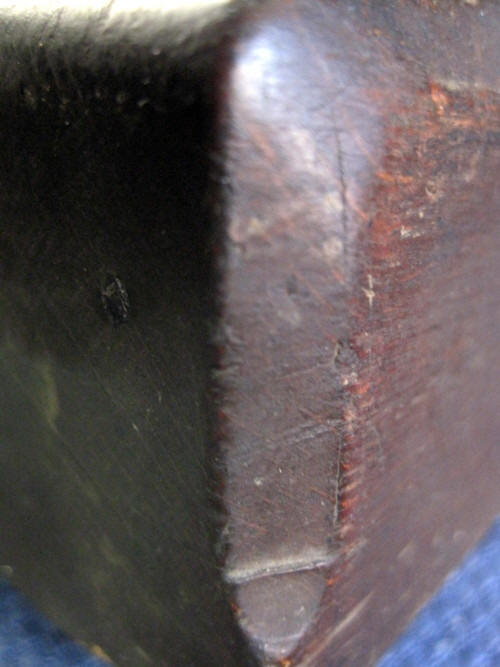 The
plane is a 24 inch jointer plane that is 3 1/8 inches wide and 2 1/4" deep.
The body appears to be made of American beech, but the wedge appears to be
yellow birch, and the tote made of mahogany. The closed tote is strongly
offset to the right side. The body has a wooden strike button about 4 1/2
inches behind the toe. It has flat chamfers about 5/16 inches wide, that
terminate on the toe and heel with a "step and turnout" as described by Slaney
for the Wilbur molding planes.
The
plane is a 24 inch jointer plane that is 3 1/8 inches wide and 2 1/4" deep.
The body appears to be made of American beech, but the wedge appears to be
yellow birch, and the tote made of mahogany. The closed tote is strongly
offset to the right side. The body has a wooden strike button about 4 1/2
inches behind the toe. It has flat chamfers about 5/16 inches wide, that
terminate on the toe and heel with a "step and turnout" as described by Slaney
for the Wilbur molding planes.

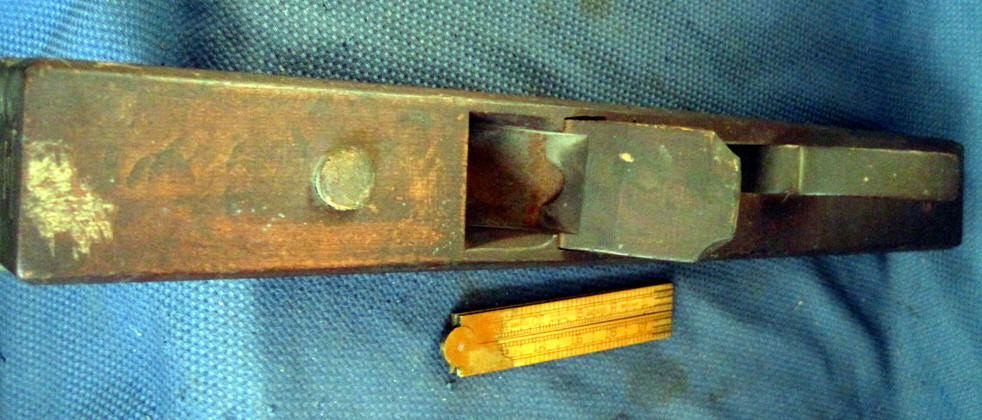
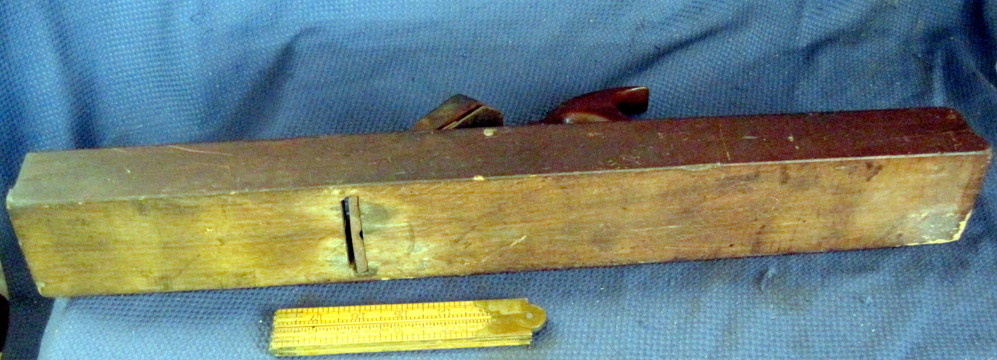
The wedge on this plane is interesting. It has angled
corners at the top, that just about mirror the upper edges of the underlying
blade. These angled corners are also noteworthy for having gouged
chamfers. Something that I've not seen before. Also the back of the
wedge, instead of having a flat bottomed channel or dado to accommodate the end
of the fixing nut that holds the underlying blade to the cap iron, this one has
a convex channel, and appears to be formed with a round plane.
Consequently, the front edge of the wedge expresses this channel as a semilunar
edge when viewed from the top.
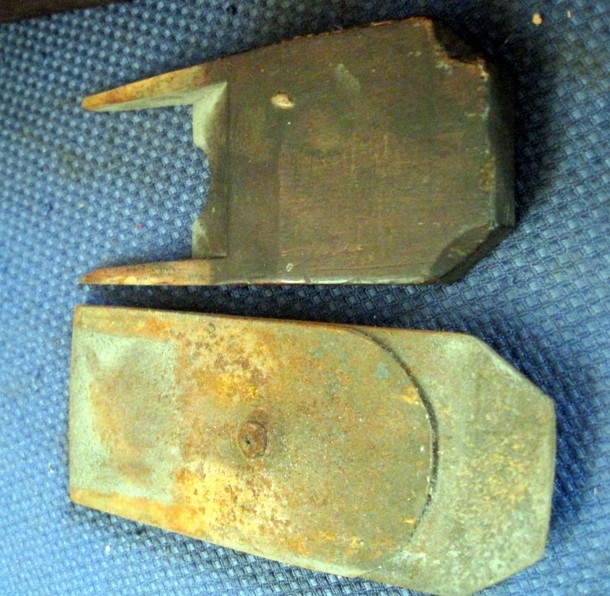
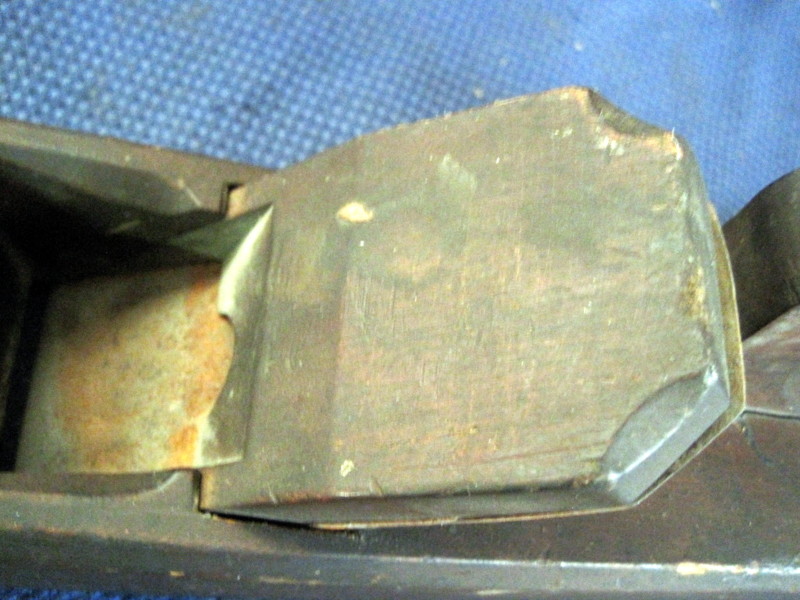
The blade and cap iron could be original. The former is
fairly thin and tapered, and has no mark. It is almost completely used up.
The cap iron is also thin and tapered (to a very thin top that is smoothly
rounded). Because the plane really has suffered relatively little wear to
the sole, I surmise that the blade was not well tempered and hardened, and must
have required frequent sharpenings.
In general for a plane of this age it is quite good condition.
There is a little punkiness to the wood at one edge near the heel, but there are
no worm holes, and the checking is minimal. It is a very nice example of a
jointer plane that dates to about 1800. It was a good trip to the flea
market!
After talking about this plane with Mike Humphrey, a student of
Southeastern Massachusetts plane makers, he put me in touch with the Newport
(RI) Restoration Foundation. This organization, founded by Doris Duke, is
in the business of restoring vintage Newport homes, and maintaining at least two
museums of early Newport furniture and accessories. Their offices are
housed at 51 Touro St. in in Newport. And this house turns out to be the
only surviving one to have been built by Joshua Wilbur (about 1800).
The people at the Newport Restoration Foundation were more than
happy to purchase this plane--made by Joshua Wilbur at about the same time as he
built this wonderful 3-story house--and they expect to display it in the house
that he built more than 200 years ago.
It is hard to think of a more worthwhile end to a great trip to
the flea market!